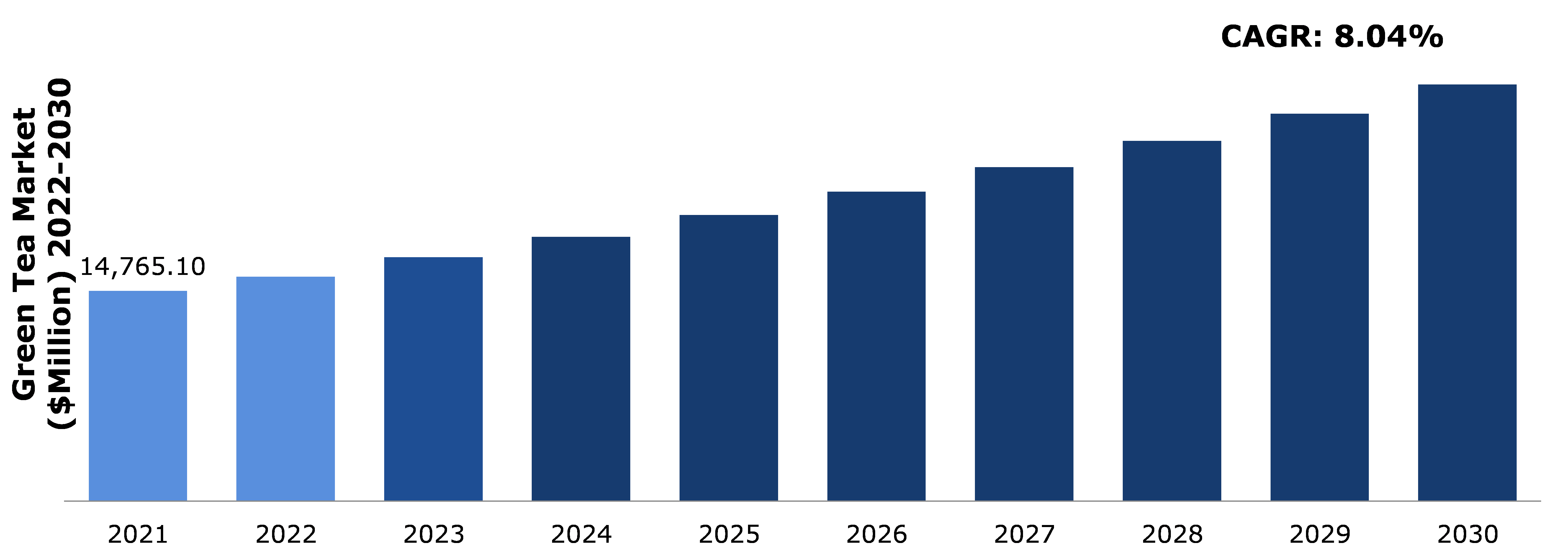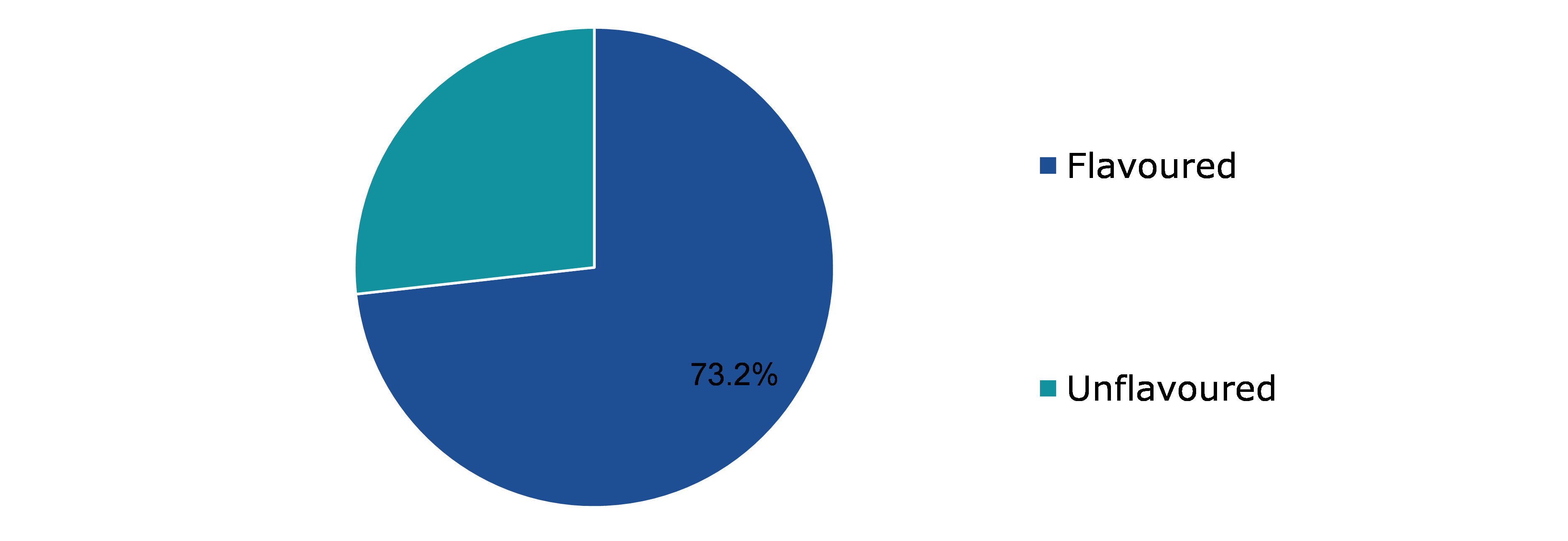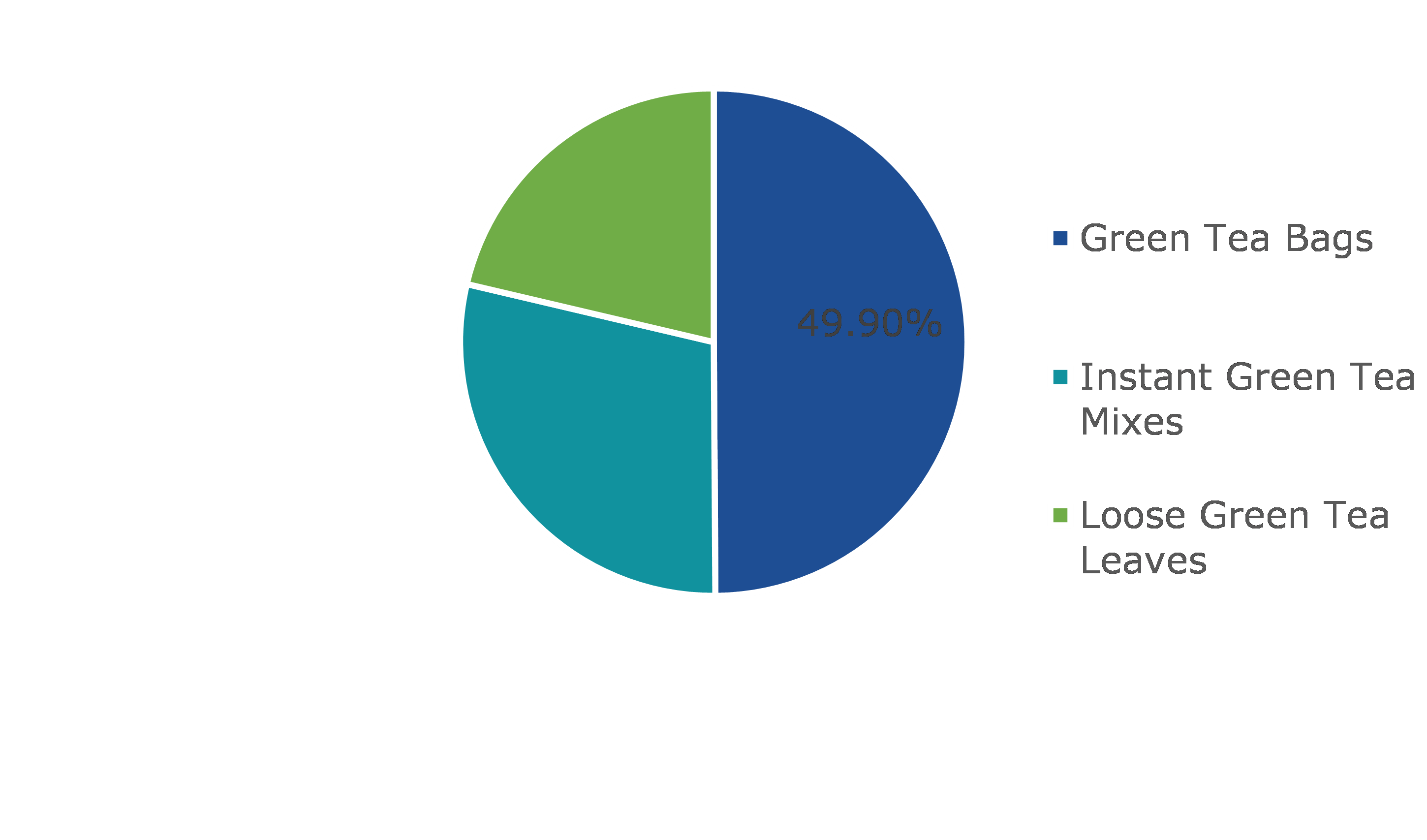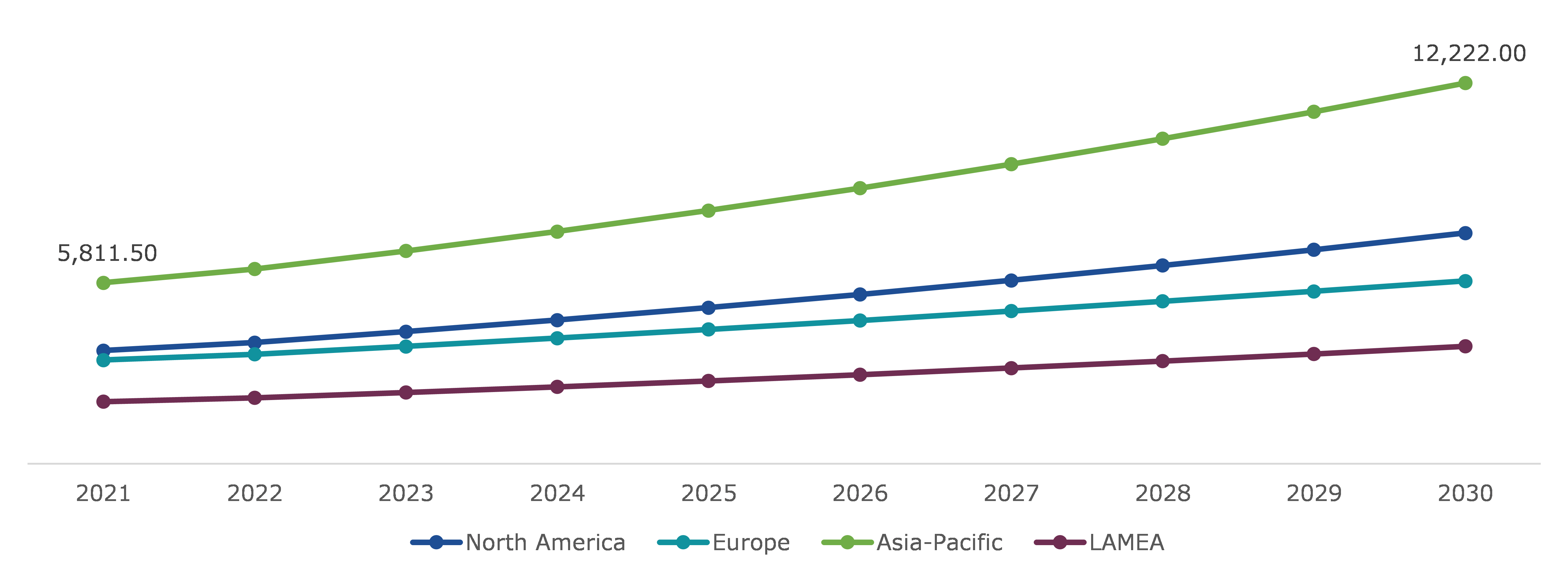Green Tea Market Report
RA08503
Green Tea Market by Type (Flavored and Unflavored), Form (Green Tea Bags, Loose Green Tea Leaves, and Instant Green Tea Mixes), Distribution Channel (Supermarket/Hypermarket, Convenience Stores/Specialty Stores, and Online), and Regional Analysis (North America, Europe, Asia-Pacific, and LAMEA): Global Opportunity Analysis and Industry Forecast, 2021-2030
Global Green Tea Market Analysis
The global green tea market is estimated to generate a revenue of $29,267.30 million by 2030, increasing from $14,765.10 million in 2021, at a noteworthy CAGR of 8.04%.
Source: Research Dive Analysis
Market Synopsis
Increased demand for healthy beverages among consumers due to high prevalence of lifestyle related health conditions like obesity and high blood pressure is likely to drive the market for green tea in the forecast time period. Consumers are more focused on living a healthy lifestyle, which raises knowledge of the health benefits of green tea. Green tea has health benefits such as lowering the risk of cardiovascular disease.
However, high cost of green tea compared to other teas available in the market such as black tea is likely to hinder the market growth in the future. People generally lack extensive knowledge about good farming practices and safe use of fertilizers by the farmers while cultivating green tea plants. This is one of the main reasons for high cost of green tea. Owing to this factor, many people prevent themselves from purchasing such high cost green tea products and this factor hinders the market growth.
According to the regional analysis of the market, the Asia-Pacific green tea market is anticipated to grow at the fastest rate during the review period. Rising consumer awareness about the benefits of green tea in curing various diseases like anxiety is further expected to drive Asia-Pacific market size growth.
Green Tea Overview
Green tea has become a popular organic, healthy, and a plant-based beverage among millennials. Green tea is dried leaves which are harvested from Camellia Sinensis. Green tea was first originated in China and today is consumed worldwide. Green tea provides many health benefits such as reducing and maintaining body weight, detoxifying the body, and more. Matcha green tea is a popular form of green tea with a slight difference that matcha is the crushed form of green tea. Lipton green tea and Tetley green tea are among the most popular green teas available for the customers today in the market.
Impact Analysis of COVID-19 on the Global Green Tea Market
The occurrence of COVID-19 pandemic has proven to be a boon for green tea market. Where other businesses experienced a major setback, the demand and production of green tea increased exponentially. Amid high rate of transmission rate and prevalence of serious symptoms, people switched to healthy options in beverages like green tea, matcha tea, and black tea. Green tea has many health benefits like it reduces acidity, maintains body weight, and boosts immunity of the person. Therefore, to prepare and protect the body against corona viral invasion, many people opted for green tea. This factor has flourished green tea market revenue growth in the pandemic period.
Also, to cater rising demand for green tea in COVID-19 scenario, the manufacturing companies increased the production of green tea. For instance, according to a news published in Ani News, a leading news agency in South Asia, on March 12, 2021, Teamonk Global's, a specialty teas company, announced that it observed a high sales peak during corona virus pandemic. The major tea that contributed to the growth of the company revenue was green tea available in a variety of flavors such as Kashmiri Kahwa, ginger, and cloves. Such factors are further anticipated to raise the market growth.
Increasing Demand for Healthy Beverages to Surge the Market Growth
Rapidly increasing lifestyle diseases like diabetes, blood pressure, obesity, anxiety, and depression are expected to accelerate the growth of green tea market share, globally. Green tea offers various health advantages like helps in weight loss, improves digestive power of body, and boosts immunity. Such factors are likely to speed up the growth of the market in the predicted time frame. Also, inclination of young generation towards functional beverages and ready to drink teas is likely to flourish the market of green tea in the next few years.
Green tea market share growth is anticipated to accelerate further due to increasing demand for healthy beverages because of growing health concern among the people worldwide. The global expansion of the green tea market is expected to accelerate by the fast increase in lifestyle disorders such as diabetes, blood pressure, obesity, anxiety, and depression due to unhealthy lifestyle. Green tea has a number of health benefits, including weight loss, improved digestive capacity, and increased immunity. Such parts are projected to accelerate green tea market share growth in the forecasted time frame. In addition, the young generation's preference for functional beverages and ready-to-drink teas is expected to increase the green tea industry in the next years
To know more about global green tea market drivers, get in touch with our analysts here.
High Cost of Green Tea to Restrain the Market Growth
Green teas are expensive beverage products due to their high nutritional content and high processing of green tea leaves in the manufacturing companies. Therefore, not many people in developing countries are able to afford green tea. This factor is expected to restrain the market growth of green tea in the forecast time period. Also, lack of awareness among people in rural areas of developing countries about the availability of healthy options in tea beverages like matcha green tea and green tea, is likely to impede the market even further.
Diversification of Product Portfolio by Major Companies to Fuel the Market Growth
Improvements in the existing green tea products and launch of new green tea products are expected to drive the market in future. Major market players in the green tea market have started focusing on new products to meet the rising demand for high nutrition beverages like matcha green tea and green tea. For instance, according to a news published by United News India, a multi lingual news agency based in India, on August 19, 2021, Tetley, a famous green tea brand from the house of Tata Consumers Products Ltd., introduced a new green tea product in the market by the name, ‘Green Tea Immune’ which is a rich source of vitamin C and helps in boosting the person’s immunity. The company has launched the product in four different flavors like classic, ginger & mint, mango variant, and lemon & honey to attract a larger consumer base. Such factors are anticipated to drive the market in future.
To know more about global green tea market opportunities, get in touch with our analysts here.
Global Green Tea Market, by Type
The global green tea market by type is segmented into flavored and unflavored. Flavored green tea sub-segment is projected to generate both maximum revenue and fastest growth.
Global Green Tea Market Share, by Type, 2021
Source: Research Dive Analysis
The flavored green tea sub-segment is predicted to have a dominating market share in the global market during the forecast period. The growth is attributed to rising demand of people for flavored beverages to enhance their taste. Many companies have launched their new green tea products in various flavors like lemon and ginger to satisfy their consumers’ taste pallets. Also, many people are not very fond of original green tea taste and therefore, they demand for alternate flavors in green tea. Such factors are anticipated to generate a huge revenue in the green tea market.
Global Green Tea Market, by Form
The global green tea market by form is segmented into green tea bags, loose green tea leaves, and instant green tea mixes. Green tea bags sub-segment is projected to generate maximum revenue.
Global Green Tea Market Share, by Form, 2021
Source: Research Dive Analysis
The green tea bags sub-segment is predicted to have the highest market share in the global market during the forecast period. Green tea bags are very easy and convenient to carry during travel. Also, it is easy to prepare tea with the help of green tea bags as they are hassle free and there is no need of many utensils. Apart from this, used green tea bags are also used by young generation to treat their skin issues like rashes and irritation. Such factors are likely to stimulate the market growth in the future.
Global Green Tea Market, by Distribution Channel
The global green tea market by distribution channel is segmented into supermarket/hypermarket, convenience stores/specialty stores, and online. Supermarket/hypermarket sub-segment is projected to generate maximum revenue and online sub-segment to generate fastest growth.
Global Green Tea Market Share, by Distribution Channel, 2021 & 2030
Source: Research Dive Analysis
The supermarket/hypermarket sub-segment is predicted to have a dominating market share in the global market during the forecast period. The sub-segment is projected to show an impressive growth in future owing to large number of shopping stores across the world. Supermarket/hypermarket offers a sense of satisfaction of hand picking goods on their own. Also, the products are properly displayed on the shelves which provide the customers a better clarity about the product they wish to buy. Also, people can instantly buy green tea of any flavor of their choice on the spot. All these factors are likely to boost the market growth in the coming years.
Global Green Tea Market, Regional Insights:
The green tea market was investigated across North America, Europe, Asia-Pacific, and LAMEA.
Global Green Tea Market Size & Forecast, By Region, 2021 & 2030
Source: Research Dive Analysis
The Market for Green Tea in Asia-Pacific to be the Most Dominant
The Asia-Pacific green tea market share is projected to be the most dominating during the timeframe. The growth is attributed to the presence of major green tea producing countries like China, Pakistan, India, and Sri Lanka in the world. As the environmental factors in the region like temperature, humidity, and soil texture are appropriate for the tea cultivation, many countries such as China and India have focused on cultivating tea on many hectors of land. Also, countries like China and Japan have largest consumption of functional beverages like green tea, matcha tea, and specialty teas that are rich source of nutrition. Such factors are further anticipated to boost the market growth in the region.
Competitive Scenario in the Global Green Tea Market
Product launches and acquisitions are common strategies followed by major market players.
Source: Research Dive Analysis
The companies involved in the green tea market are Unilever Plc., Tata Consumer Products ltd., Typhoo Tea, Associated British Foods Plc., The Begilow Tea Company, Tazo Tea Company, Numi Organic Tea, The Republic of Tea, Inc., East West Tea Company LLC., and Northern Tea Merchants Ltd.
| Aspect | Particulars |
| Historical Market Estimations | 2020-2021 |
| Base Year for Market Estimation | 2021 |
| Forecast Timeline for Market Projection | 2021-2030 |
| Geographical Scope | North America, Europe, Asia-Pacific, LAMEA |
| Segmentation by Type |
|
| Segmentation by Form |
|
| Segmentation by Distribution Channel |
|
| Key Companies Profiled |
|
Q1. What is the size of the green tea market?
A. The global green tea market is estimated to generate a revenue of $29,267.30 million by 2030, increasing from $14,765.10 million in 2021, at a noteworthy CAGR of 8.04%.
Q2. Which are the major companies in the green tea market?
A. Unilever Plc and Tata Consumer Products Ltd. are some of the prominent companies in the green tea market.
Q3. Which region, among others, possesses greater investment opportunities in the near future?
A. The Asia-Pacific region possesses great investment opportunities for investors to witness the most promising growth in the future.
Q4. What will be the growth rate of the Asia-Pacific green tea market?
A. The share of Asia-Pacific market is anticipated to grow at a CAGR of 8.75%.
Q5. What is the healthiest green tea?
A. Matcha green tea is considered as the healthiest green tea as it contains more nutrition compared to normal green tea.
Q6. What happens if you drink green tea every day?
A. Drinking green tea everyday may cause insomnia in most people. Also, most people may suffer from other health conditions such as stomach ache, iron deficiency, and diarrhea.
Q7. Why green tea is bad for you?
A. Green tea contains a chemical called tannins which is responsible for increasing the amount of acid in your stomach. That is why excess drinking of green tea can have some harmful effects on you.
Q8. What kind of green tea should I drink?
A. Matcha tea is the best type of green tea which can be consumed as it is the healthiest form of green tea.
Q9. Why does matcha taste so bad?
A. Matcha tea is bitter in taste because the green tea leaves present in matcha tea contain chlorophyll, a chemical helpful in photosynthesis process. As soon as the leaves are exposed to heat, the chemical chlorophyll breaks down and gives a bitter flavor to the matcha tea.
1.Research Methodology
1.1.Desk Research
1.2.Real time insights and validation
1.3.Forecast model
1.4.Assumptions and forecast parameters
1.5.Market size estimation
1.5.1.Top-down approach
1.5.2.Bottom-up approach
2.Report Scope
2.1.Market definition
2.2.Key objectives of the study
2.3.Report overview
2.4.Market segmentation
2.5.Overview of the impact of COVID-19 on Global green tea market
3.Executive Summary
4.Market Overview
4.1.Introduction
4.2.Growth impact forces
4.2.1.Drivers
4.2.2.Restraints
4.2.3.Opportunities
4.3.Market value chain analysis
4.3.1.List of raw material suppliers
4.3.2.List of manufacturers
4.3.3.List of distributors
4.4.Innovation & sustainability matrices
4.4.1.Technology matrix
4.4.2.Regulatory matrix
4.5.Porter’s five forces analysis
4.5.1.Bargaining power of suppliers
4.5.2.Bargaining power of consumers
4.5.3.Threat of substitutes
4.5.4.Threat of new entrants
4.5.5.Competitive rivalry intensity
4.6.PESTLE analysis
4.6.1.Political
4.6.2.Economical
4.6.3.Social
4.6.4.Technological
4.6.5.Environmental
4.7.Impact of COVID-19 on green tea market
4.7.1.Pre-covid market scenario
4.7.2.Post-covid market scenario
5.Green Tea Market Analysis, by Type
5.1.Overview
5.2.Flavored
5.2.1.Definition, key trends, growth factors, and opportunities
5.2.2.Market size analysis, by region
5.2.3.Market share analysis, by country
5.3.Unflavored
5.3.1.Definition, key trends, growth factors, and opportunities
5.3.2.Market size analysis, by region
5.3.3.Market share analysis, by country
5.4.Research Dive Exclusive Insights
5.4.1.Market attractiveness
5.4.2.Competition heatmap
6.Green Tea Market Analysis, by Form
6.1.Green Tea Bags
6.1.1.Definition, key trends, growth factors, and opportunities
6.1.2.Market size analysis, by region
6.1.3.Market share analysis, by country
6.2.Loose Green Tea Leaves
6.2.1.Definition, key trends, growth factors, and opportunities
6.2.2.Market size analysis, by region
6.2.3.Market share analysis, by country
6.3.Instant Green Tea Mixes
6.3.1.Definition, key trends, growth factors, and opportunities
6.3.2.Market size analysis, by region
6.3.3.Market share analysis, by country
6.4.Research Dive Exclusive Insights
6.4.1.Market attractiveness
6.4.2.Competition heatmap
7.Green Tea Market Analysis, by Distribution Channel
7.1.Supermarket/Hypermarket
7.1.1.Definition, key trends, growth factors, and opportunities
7.1.2.Market size analysis, by region
7.1.3.Market share analysis, by country
7.2.Convenience Stores/Specialty Stores
7.2.1.Definition, key trends, growth factors and opportunities
7.2.2.Market size analysis, by region
7.2.3.Market share analysis, by country
7.3.Others
7.3.1.Definition, key trends, growth factors, and opportunities
7.3.2.Market size analysis, by region
7.3.3.Market share analysis, by country
7.4.Research Dive Exclusive Insights
7.4.1.Market attractiveness
7.4.2.Competition heatmap
8.Green Tea Market, by Region
8.1.North America
8.1.1.U.S.
8.1.1.1.Market size analysis, by Type
8.1.1.2.Market size analysis, by Form
8.1.1.3.Market size analysis, by Distribution Channel
8.1.2.Canada
8.1.2.1.Market size analysis, by Type
8.1.2.2.Market size analysis, by Form
8.1.2.3.Market size analysis, by Distribution Channel
8.1.3.Mexico
8.1.3.1.Market size analysis, by Type
8.1.3.2.Market size analysis, by Form
8.1.3.3.Market size analysis, by Distribution Channel
8.1.4.Research Dive Exclusive Insights
8.1.4.1.Market attractiveness
8.1.4.2.Competition heatmap
8.2.Europe
8.2.1.Germany
8.2.1.1.Market size analysis, by Type
8.2.1.2.Market size analysis, by Form
8.2.1.3.Market size analysis, by Distribution Channel
8.2.2.UK
8.2.2.1.Market size analysis, by Type
8.2.2.2.Market size analysis, by Form
8.2.2.3.Market size analysis, by Distribution Channel
8.2.3.France
8.2.3.1.Market size analysis, by Type
8.2.3.2.Market size analysis, by Form
8.2.3.3.Market size analysis, by Distribution Channel
8.2.4.Spain
8.2.4.1.Market size analysis, by Type
8.2.4.2.Market size analysis, by Form
8.2.4.3.Market size analysis, by Distribution Channel
8.2.5.Italy
8.2.5.1.Market size analysis, by Type
8.2.5.2.Market size analysis, by Form
8.2.5.3.Market size analysis, by Distribution Channel
8.2.6.Rest of Europe
8.2.6.1.Market size analysis, by Type
8.2.6.2.Market size analysis, by Form
8.2.6.3.Market size analysis, by Distribution Channel
8.2.7.Research Dive Exclusive Insights
8.2.7.1.Market attractiveness
8.2.7.2.Competition heatmap
8.3.Asia Pacific
8.3.1.China
8.3.1.1.Market size analysis, by Type
8.3.1.2.Market size analysis, by Form
8.3.1.3.Market size analysis, by Distribution Channel
8.3.2.Japan
8.3.2.1.Market size analysis, by Type
8.3.2.2.Market size analysis, by Form
8.3.2.3.Market size analysis, by Distribution Channel
8.3.3.India
8.3.3.1.Market size analysis, by Type
8.3.3.2.Market size analysis, by Form
8.3.3.3.Market size analysis, by Distribution Channel
8.3.4.Australia
8.3.4.1.Market size analysis, by Type
8.3.4.2.Market size analysis, by Form
8.3.4.3.Market size analysis, by Distribution Channel
8.3.5.South Korea
8.3.5.1.Market size analysis, by Type
8.3.5.2.Market size analysis, by Form
8.3.5.3.Market size analysis, by Distribution Channel
8.3.6.Rest of Asia Pacific
8.3.6.1.Market size analysis, by Type
8.3.6.2.Market size analysis, by Form
8.3.6.3.Market size analysis, by Distribution Channel
8.3.7.Research Dive Exclusive Insights
8.3.7.1.Market attractiveness
8.3.7.2.Competition heatmap
8.4.LAMEA
8.4.1.Brazil
8.4.1.1.Market size analysis, by Type
8.4.1.2.Market size analysis, by Form
8.4.1.3.Market size analysis, by Distribution Channel
8.4.2.Saudi Arabia
8.4.2.1.Market size analysis, by Type
8.4.2.2.Market size analysis, by Form
8.4.2.3.Market size analysis, by Distribution Channel
8.4.3.UAE
8.4.3.1.Market size analysis, by Type
8.4.3.2.Market size analysis, by Form
8.4.3.3.Market size analysis, by Distribution Channel
8.4.4.South Africa
8.4.4.1.Market size analysis, by Type
8.4.4.2.Market size analysis, by Form
8.4.4.3.Market size analysis, by Distribution Channel
8.4.5.Rest of LAMEA
8.4.5.1.Market size analysis, by Type
8.4.5.2.Market size analysis, by Form
8.4.5.3.Market size analysis, by Distribution Channel
8.4.6.Research Dive Exclusive Insights
8.4.6.1.Market attractiveness
8.4.6.2.Competition heatmap
9.Competitive Landscape
9.1.Top winning strategies, 2021
9.1.1.By strategy
9.1.2.By year
9.2.Strategic overview
9.3.Market share analysis, 2021
9.4.Top Five Players Market Overview
10.Company Profiles
10.1.Unilever Plc.
10.1.1.Business overview
10.1.2.Financial performance
10.1.3.Product portfolio
10.1.4.Recent strategic moves & developments
10.1.5.SWOT analysis
10.2.Tata Consumer Products ltd.
10.2.1.Business overview
10.2.2.Financial performance
10.2.3.Product portfolio
10.2.4.Recent strategic moves & developments
10.2.5.SWOT analysis
10.3.Typhoo Tea
10.3.1.Business overview
10.3.2.Financial performance
10.3.3.Product portfolio
10.3.4.Recent strategic moves & developments
10.3.5.SWOT analysis
10.4.Associated British Foods Plc
10.4.1.Business overview
10.4.2.Financial performance
10.4.3.Product portfolio
10.4.4.Recent strategic moves & developments
10.4.5.SWOT analysis
10.5.The Begilow Tea Company
10.5.1.Business overview
10.5.2.Financial performance
10.5.3.Product portfolio
10.5.4.Recent strategic moves & developments
10.5.5.SWOT analysis
10.6.Tazo Tea Company
10.6.1.Business overview
10.6.2.Financial performance
10.6.3.Product portfolio
10.6.4.Recent strategic moves & developments
10.6.5.SWOT analysis
10.7.Numi Organic Tea
10.7.1.Business overview
10.7.2.Financial performance
10.7.3.Product portfolio
10.7.4.Recent strategic moves & developments
10.7.5.SWOT analysis
10.8.The Republic of Tea, Inc
10.8.1.Business overview
10.8.2.Financial performance
10.8.3.Product portfolio
10.8.4.Recent strategic moves & developments
10.8.5.SWOT analysis
10.9.East West Tea Company LLC
10.9.1.Business overview
10.9.2.Financial performance
10.9.3.Product portfolio
10.9.4.Recent strategic moves & developments
10.9.5.SWOT analysis
10.10.Northern Tea Merchants Ltd
10.10.1.Business overview
10.10.2.Financial performance
10.10.3.Product portfolio
10.10.4.Recent strategic moves & developments
10.10.5.SWOT analysis
11.Appendix
11.1.Parent & peer market analysis
11.2.Premium insights from form experts
11.3.Related reports
In the present day, there is no doubt that world is increasingly favoring green tea. Trends reveal that the global tea market has expanded in the past few years and tea lovers are fuelling up this growth every passing year.
Today’s consumers highly prefer healthier alternatives to sugared fruit juices, soft drinks, and sometimes even coffee. The choice of tastes have altered since past few years. Urbane consumers are inclining greatly toward more healthy alternatives. The trend for green tea is driven by the awareness and understanding among consumers about the benefits of organic food and beverages. Additionally, the increasing diseases, have also triggered a need among consumers to go for a more practical, instead of volatile approach to their health.
The health benefits offered by green tea are boosting its demand profoundly on a global scale. The global green tea market is witnessing boosted growth mainly owing to the availability of various options in the flavors of green tea. Among all the variants of teas, green tea is the least treated and offers the most antioxidant polyphenols, particularly a catechin named epigallocatechin-3-gallate (EGCG), which is supposed to be accountable for most of the health benefits associated to green tea.
Even though, black tea as well as green tea are sourced from the same plant, green tea is quite different owing to its specific processing technique, color, subtle flavors, and better health benefits. Globally, the manufacturing of black tea has surged by only 3%, while it is around 6.4% in the case of green tea.
Green Tea Market Trends and Developments
Many tea manufacturers are coming up with innovative green teas in different flavors, such as lemon and ginger, to satisfy the taste buds of their potential customers. Some of the leading players active in the green tea market are concentrating on emerging strategies, such as partnerships, product development, mergers and acquisitions, and collaborations to achieve a foremost position in the global market. For instance,
- In January 2021, Tata Consumer Products, the second-largest manufacturer & distributor of tea and a major producer of coffee across the globe, strengthened its wellness portfolio in the packaged beverages category in order to cater to consumer needs by introducing two new products – TATA Tea Gold Care and TATA Tea Tulsi Green, and reformulated its existing Tetley Green Tea with added Vitamin C.
- In January 2022, Numi Organic Tea, known for its assortment of organic & fair trade certified teas, entered into a partnership with WeWork, the leading global flexible space providers, to become its exclusive tea partner. With this partnership, Numi will provide its tea products to WeWork members in over 275 locations and more than 1,000 pantries in the United States and Canada.
- In March 2022, Shizuru announced the launch of Japan’s finest green tea, Ocha in India, which is loved across the world for its restorative qualities. EIJ Consulting is bringing Ocha green tea to India in three distinct flavors —Genmaicha, Sencha, and Gyokuro.
COVID-19 Impact on the Green Tea Industry
The unexpected outburst of the coronavirus pandemic has positively impacted the global green tea market. This is mainly because numerous people have started adopting healthy lifestyle and eating and drinking habits to prepare and safeguard their body against the deadly virus during the lockdown period. This has boosted the consumption of green tea among people, due to its amazing health benefits, which is boosting the market growth.
To sum up, the future of the green tea industry is unquestionably sanguine and the industry is estimated to be one of the most revenue generating segments of the global tea market in the forthcoming years.
Forecast Analysis of Global Green Tea Market
The global green tea market is projected to witness a striking growth during the forecast period, owing to the launch of new green tea products and improvements in the existing products. In addition, the growing demand for high nutrition beverages like matcha green tea is expected to create huge growth opportunities for the global market. Conversely, the lack of awareness among people in developing countries and the high costs of green tea are factors expected to hamper the market growth in the projected timeframe.
The rising demand for healthy beverages and the rapidly increasing lifestyle diseases like blood pressure, diabetes, anxiety, obesity, and depression are the significant factors estimated to propel the growth of the global green tea market in the coming future. According to a latest report published by Research Dive, the global green tea market is expected to garner $29,267.30 million during the forecast period (2022-2030). Regionally, the Asia-Pacific region is estimated to dominate in the global industry, mainly due to the presence of major green tea producing countries like India, China, Pakistan, and Sri Lanka in the region.
The key players functioning in the global green tea market include Unilever Plc., Typhoo Tea, Tata Consumer Products ltd., Associated British Foods Plc., Tazo Tea Company, The Begilow Tea Company, Numi Organic Tea, East West Tea Company LLC, The Republic of Tea, Inc., and Northern tea Merchants Ltd..
Personalize this research
- Triangulate with your own data
- Request your format and definition
- Get a deeper dive on a specific application, geography, customer or competitor
- + 1-888-961-4454 Toll - Free
- support@researchdive.com







